Egypt Diabetes Drugs Market Size
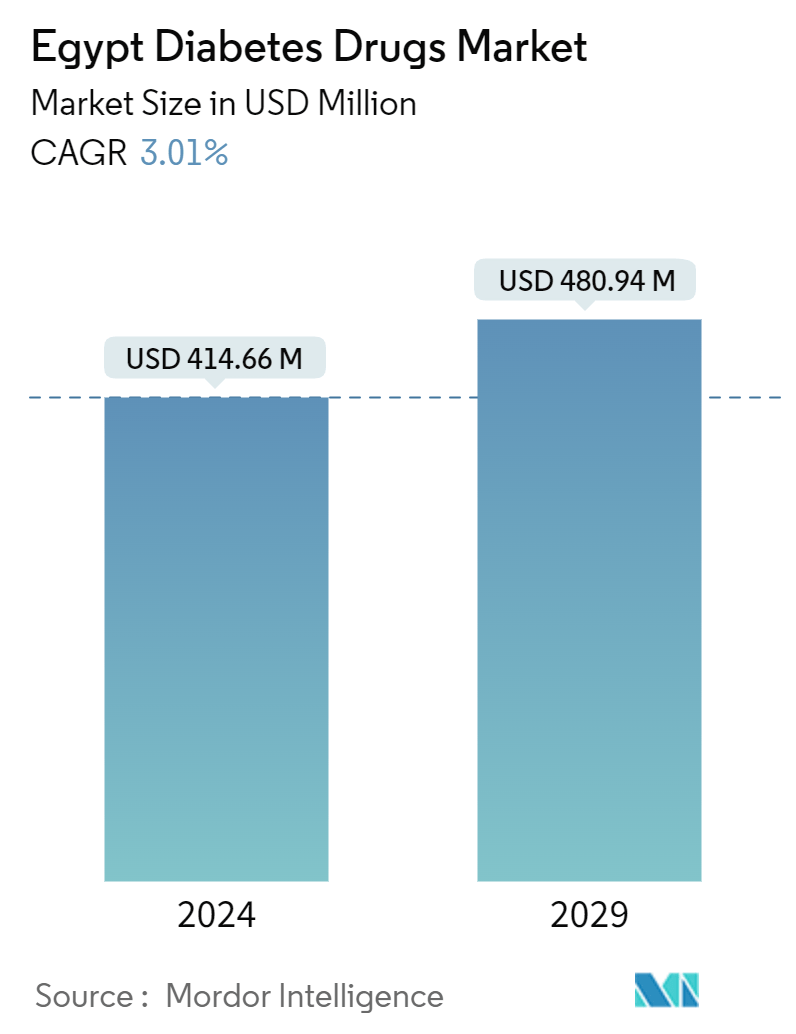
| Study Period | 2019 - 2029 |
| Base Year For Estimation | 2023 |
| Market Size (2024) | USD 414.66 Million |
| Market Size (2029) | USD 480.94 Million |
| CAGR (2024 - 2029) | 3.01 % |
| Market Concentration | High |
Major Players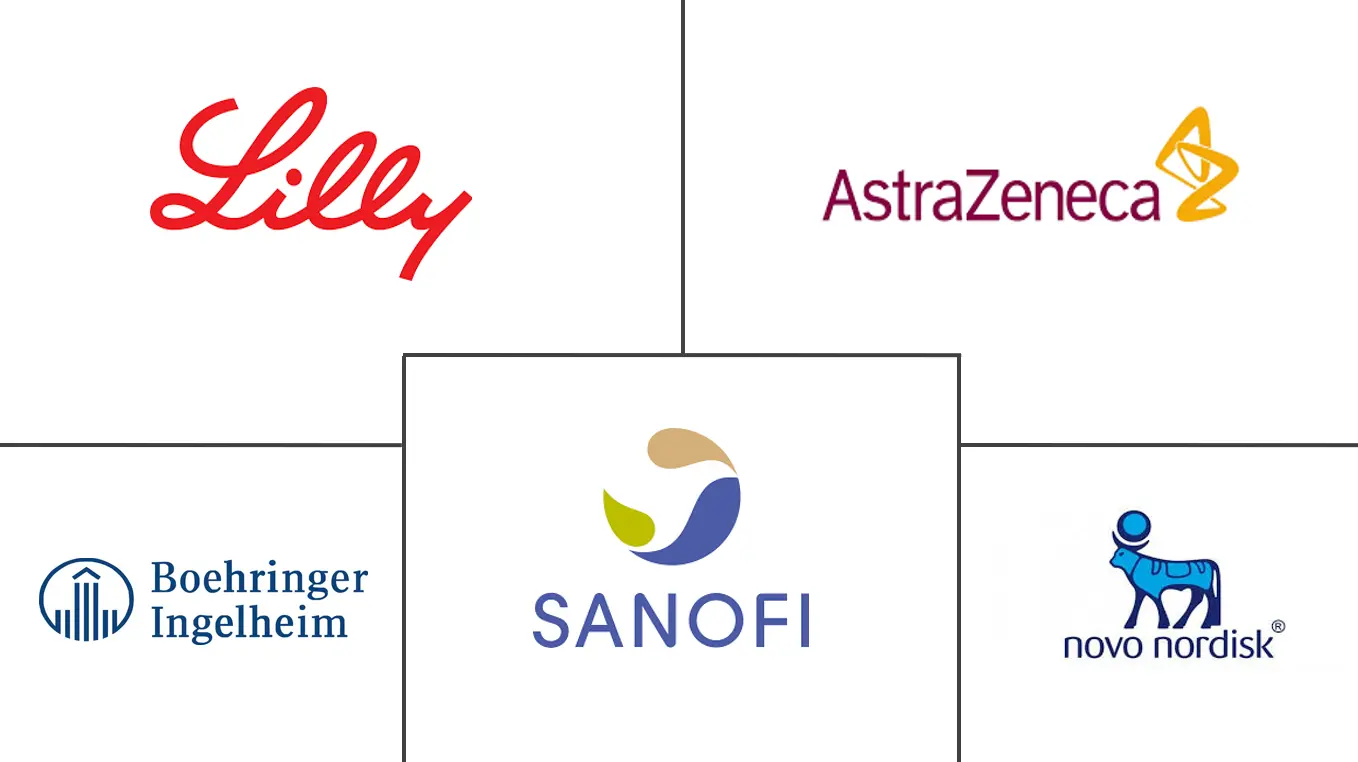
*Disclaimer: Major Players sorted in no particular order |
Egypt Diabetes Drugs Market Analysis
The Egypt Diabetes Drugs Market size is estimated at USD 414.66 million in 2024, and is expected to reach USD 480.94 million by 2029, growing at a CAGR of 3.01% during the forecast period (2024-2029).
The Egyptian diabetes drug market is driven by factors such as the rising prevalence of diabetes in Egypt and advancement in treatment options and government initiatives.
The increasing burden of diabetes in Egypt is significantly boosting the market for diabetes drugs. The prevalence of diabetes in Egypt has risen sharply due to factors such as urbanization, dietary changes, and sedentary lifestyles, which have created a substantial demand for effective diabetes management solutions. This rising incidence drives the need for a variety of diabetes medications, including oral hypoglycemics and insulin therapies, to manage and control blood sugar levels. For instance, according to the International Diabetes Federation (IDF) data published in 2022, the number of adults with diabetes in Egypt is projected to rise to 9.5 million by 2030 and 11.8 million by 2045.
In addition, as per a study article published in BMC Public Health in May 2023, Egypt has the 9th highest prevalence of diabetes worldwide, with around 18.4% of adults affected. This equates to over 11 million people with diagnosed type 2 diabetes. Diabetes is a major cause of premature mortality, morbidity, and loss of economic growth in Egypt. Sedentary lifestyles and unhealthy dietary habits, including increased consumption of processed foods, sugary drinks, and red meat, are contributing to the rise in diabetes prevalence in Egypt. Thus, the high burden of diabetes in Egypt is expected to increase demand for effective management, thereby contributing to market growth during the forecast period.
Further, government initiatives in Egypt are crucial in boosting the market for diabetes drugs. The Egyptian government has implemented various health policies and programs to tackle the rising prevalence of diabetes, including subsidized healthcare services, public awareness campaigns, and screening programs. These initiatives enhance early diagnosis and treatment, leading to increased demand for diabetes medications.
For instance, in March 2024, under the leadership of Dr. Ahmed El-Sobky, the Chairman of the Board and Supervisor General of the Universal Health Insurance and Haya Kareema projects at the Ministry of Health and Population, the Egypt Healthcare Authority unveiled the "Ramadan Health for the Whole Family" initiative. This initiative will be rolled out across provinces implementing the universal health insurance system. Dr. El-Sobky further elaborated that the initiative focuses on medical monitoring for three patient categories: individuals with diabetes, those with hypertension, and patients presenting both conditions. Thus, the government’s efforts to prioritize diabetes management in public health strategies and support the availability of innovative therapies, these initiatives are driving both demand and investment in the diabetes drug market.
Further, strategic activities by industry players in the country are expected to increase access to diabetes drugs, contributing to the market expansion during the forecast period. For instance, in December 2022, Egypt's Medical Union Pharmaceutical Company (MUP) unveiled a new high-capacity insulin production line, as announced by Khaled Abdel-Ghaffar, the Minister of Health and Population.
The high burden of diabetes, increasing government initiatives, and key strategic activities by market players in the country are all important factors. However, the high cost of treatment and limited infrastructure in the country are expected to restrain the market during the projected period.
Egypt Diabetes Drugs Market Trends
The Basal or Long-acting Insulins Segment Holds a Significant Market Share During the Forecast Period
Basal or long-acting insulin is used to help manage blood glucose levels in people with diabetes. Unlike rapid-acting insulins, which work quickly to control blood sugar spikes after meals, basal insulins are designed to provide a steady level of insulin throughout the day and night. This significantly helps to maintain stable blood glucose levels between meals and overnight.
The increasing study highlights the potential efficacy of long-acting insulin in managing and treating diabetes, which may increase its adoption, contributing to the segment growth during the forecast period. For instance, according to the study published in Current Diabetes Revision in May 2024, a study on the rate of insulin use and glycemic control among Egyptian patients with T2DM found that more than half (56.4%) of the insulin-treated patients were on basal insulin, mainly long-acting insulin (90.9%). The mean basal insulin daily dose was 0.3 ± 0.1 IU/. This study highlighted the need for improved diabetes education and treatment adherence to achieve better glycemic control among Egyptian patients.
The same study noted that only 38.3% of patients received diabetes education, emphasizing the importance of national educational programs to enhance understanding and management of diabetes, particularly regarding insulin therapy. Thus, such findings indicate a growing focus on improving diabetes management through better education and access to long-acting insulin therapy in Egypt, contributing to the segment growth during the forecast period.
Further, according to the study published in the Journal of Endocrine Society in January 2024, a study comparing once-weekly insulin icodec with once-daily long-acting insulin (Insulin Glargine U100) demonstrated a significant reduction in glycated hemoglobin (HbA1c) levels with insulin icodec, along with a higher percentage of time spent in the glucose target range. The convenience of a once-weekly injection may enhance patient adherence to treatment regimens, potentially leading to better overall glycemic control and improved quality of life. Thus, the favorable results for insulin icodec could lead to increased competition in the long-acting insulin market, prompting existing manufacturers to innovate and improve their product offerings, contributing to market growth.
Thus, the high safety and efficacy of basal or long-acting insulin in the treatment of diabetes and advancement in treatment options are anticipated to expand the segment growth during the forecast period.
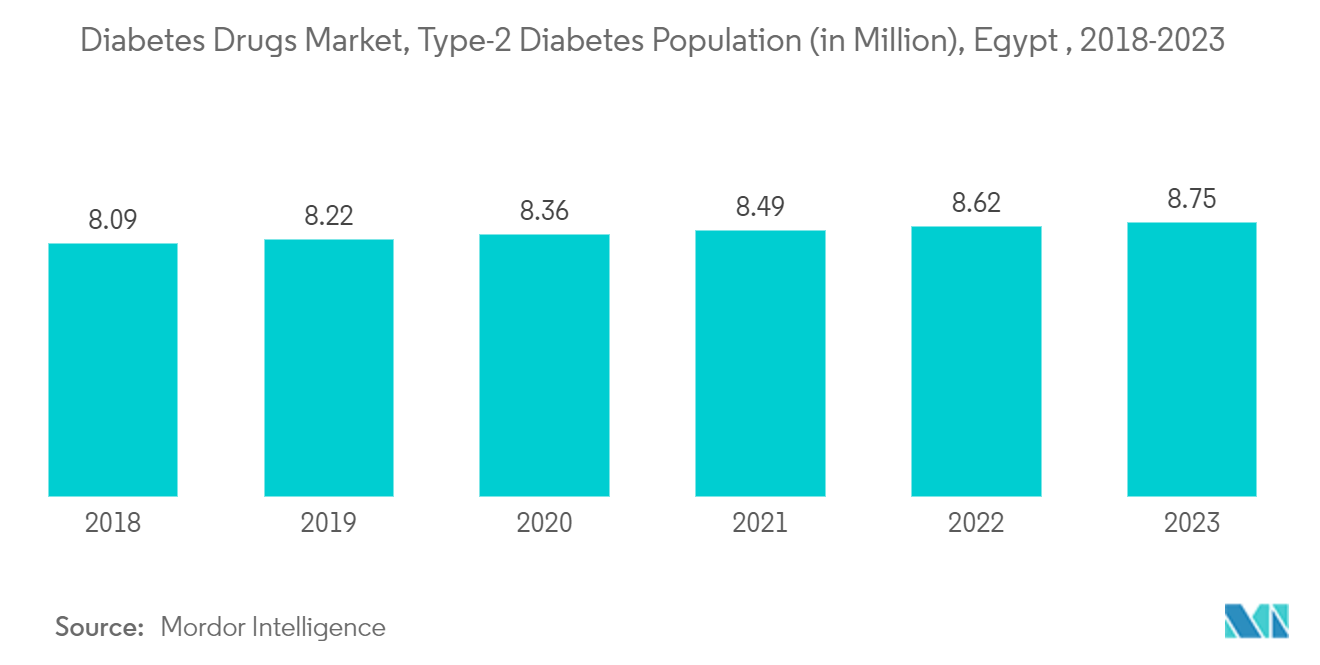
The Biguanides Segment is Expected to Experience the Fastest Growth Rate During the Forecast Period
Biguanides, a class of medications, are primarily used to treat type 2 diabetes. These medications work by reducing glucose production during digestion. Metformin is the only biguanide available in most countries for diabetes management. Well-known brand names include Glucophage (metformin), Glucophage XR (metformin extended release), Fortamet, Glumetza, and Riomet. Metformin is often combined with other diabetes medications, such as sulfonylureas.
The segment is driven by the growing prevalence of diabetics, the safety and efficacy of metformin, and the cost-effectiveness of the drug.
Diabetes shortens lifespan and can lead to severe complications such as blindness, amputations, kidney failure, heart attacks, strokes, and heart failure, often resulting in hospitalization. Metformin is the primary choice for managing hyperglycemia in type 2 diabetes mellitus (T2DM). Beyond its role as a key glucose-lowering agent, metformin boasts notable anti-inflammatory properties. However, if metformin is contraindicated, not tolerated, or fails to achieve treatment goals after three months at the maximum tolerated dose, it is necessary to consider alternative treatment options. Typically, dipeptidyl peptidase-4 (DPP-4) inhibitors, sodium-glucose cotransporter-2 (SGLT-2) inhibitors, and glucagon-like peptide-1 (GLP-1) agonists are employed to complement metformin therapy.
The key strategic activities by the market players, such as product launches, are expected to contribute to the segment growth during the forecast period. For instance, in July 2022, Zydus Lifesciences obtained final approval to market empagliflozin and metformin hydrochloride tablets in multiple strengths. When used alongside a proper diet and exercise regimen, these tablets improve glycemic control in adults with type 2 diabetes mellitus. They also reduce the risk of cardiovascular death in patients with type 2 diabetes and established cardiovascular disease.
In Egypt, social status significantly influences patients' access to healthcare. Rural areas have a sparse distribution of healthcare centers, hospitals, and pharmacies, especially compared to larger cities and urban locales. Financial status is a pivotal factor in healthcare accessibility; many Egyptian employees find their salaries insufficient to cover monthly diabetes supplies. For instance, according to the study article in Frontiers in October 2022, metformin is one of the most affordable diabetes medications available. The lowest-priced generic version of metformin has a high availability rate (≥80%) in pharmacies, making it accessible to many patients.
Thus, the growing burden of diabetes and the adoption of metformin as a first line of treatment product launches and cost-effectiveness are expected to contribute to the segment growth during the forecast period.
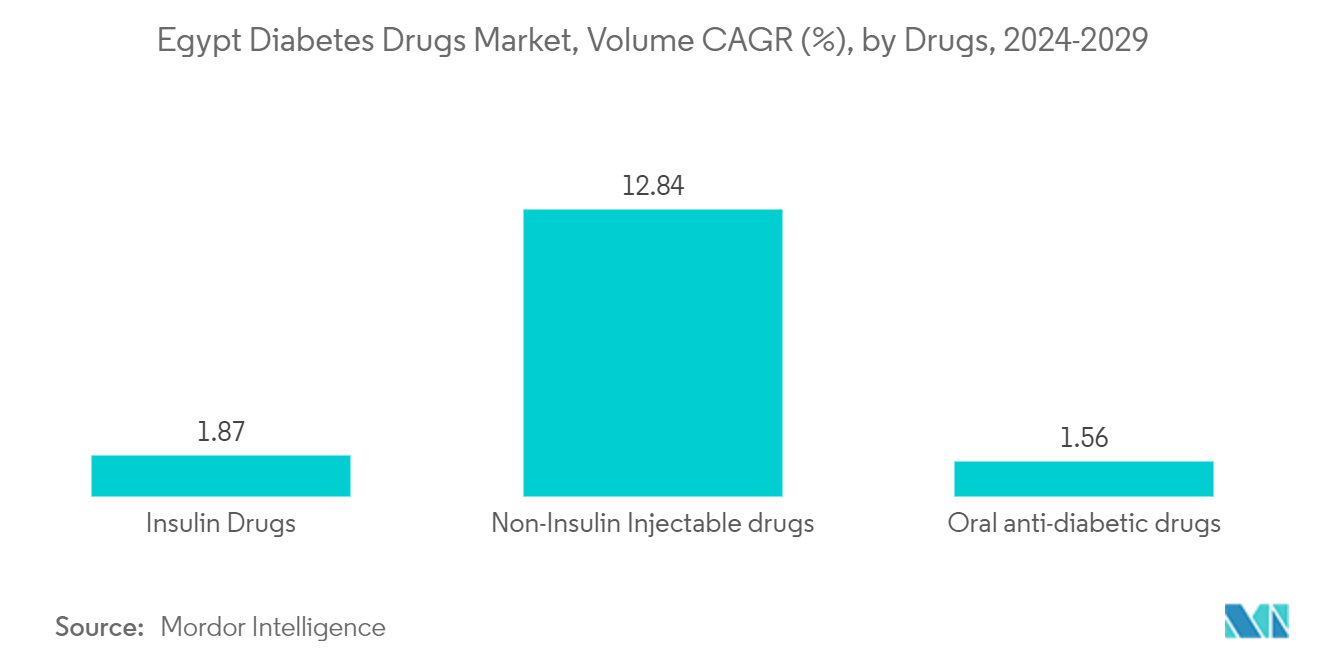
Egypt Diabetes Drugs Industry Overview
The Egyptian diabetes drugs market is consolidated, with major manufacturers, namely Eli Lilly, Sanofi, Novo Nordisk, AstraZeneca, and other generic players in the region. A large portion of the market is dominated by manufacturers consistently entering the market to create new revenue streams and enhance existing ones through strategy-based mergers and acquisitions.
Egypt Diabetes Drugs Market Leaders
-
AstraZeneca
-
Boehringer Ingelheim
-
Novo Nordisk A/S
-
Sanofi Aventis
-
Eli Lilly and Company
*Disclaimer: Major Players sorted in no particular order
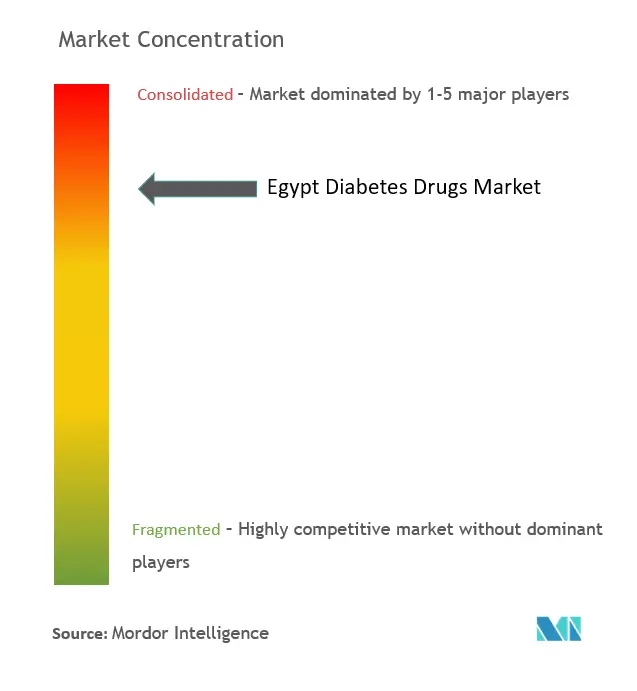
Egypt Diabetes Drugs Market News
- March 2024: Egypt announced the export of lifesaving insulin injections to Cuba. The Insulinagypt injections, manufactured in Egypt for diabetes treatment, would be shipped via the United Company for Pharmaceuticals, a subsidiary of the ACDIMA Group.
- May 2023: Eli Lilly partnered with Egypt to manufacture insulin for Africa. Eli Lilly supplies EVA Pharma in Egypt with active pharmaceutical ingredients (API) for insulin at a notably discounted rate. This initiative aims to accelerate and reduce the cost of producing this essential medication, which is crucial for treating diabetes, a rapidly escalating health concern across the continent. Also, Eli Lilly is offering a pro-bono technology transfer, empowering EVA Pharma to formulate, fill, and finalize insulin vials and cartridges. This effort aligns with Eli Lilly's global commitment to facilitate 30 million insulin doses by 2030.
Egypt Diabetes Drugs Market Report - Table of Contents
1. INTRODUCTION
- 1.1 Study Assumptions and Market Definition
- 1.2 Scope of the Study
2. RESEARCH METHODOLOGY
3. EXECUTIVE SUMMARY
4. MARKET DYNAMICS
- 4.1 Market Overview
-
4.2 Market Drivers
- 4.2.1 Increasing Prevalence of Diabetes
- 4.2.2 Advancements in Treatment Options and Active Government Initiatives
-
4.3 Market Restraints
- 4.3.1 High Treatment Costs and Limited Healthcare Infrastructure
-
4.4 Porter's Five Forces Analysis
- 4.4.1 Bargaining Power of Suppliers
- 4.4.2 Bargaining Power of Consumers
- 4.4.3 Threat of New Entrants
- 4.4.4 Threat of Substitute Products and Services
- 4.4.5 Intensity of Competitive Rivalry
5. MARKET SEGMENTATION
-
5.1 Insulins
- 5.1.1 Basal or Long-acting Insulins
- 5.1.2 Bolus or Fast-acting Insulins
- 5.1.3 Traditional Human Insulins
- 5.1.4 Biosimilar Insulins
-
5.2 Oral Anti-diabetic drugs
- 5.2.1 Biguanides
- 5.2.2 Alpha-glucosidase Inhibitors
- 5.2.3 Dopamine D2 Receptor Agonist
- 5.2.4 SGLT-2 Inhibitors
- 5.2.5 DPP-4 Inhibitors
- 5.2.6 Sulfonylureas
- 5.2.7 Meglitinides
-
5.3 Non-insulin Injectable drugs
- 5.3.1 GLP-1 Receptor Agonists
- 5.3.2 Amylin Analogue
-
5.4 Combination Drugs
- 5.4.1 Insulin Combinations
- 5.4.2 Oral Combinations
6. MARKET INDICATORS
- 6.1 Type-1 Diabetic Population
- 6.2 Type-2 Diabetic Population
7. COMPETITIVE LANDSCAPE
-
7.1 COMPANY PROFILES
- 7.1.1 Novo Nordisk A/S
- 7.1.2 Takeda
- 7.1.3 Pfizer
- 7.1.4 Eli Lilly
- 7.1.5 Janssen Pharmaceuticals
- 7.1.6 Astellas
- 7.1.7 Boehringer Ingelheim
- 7.1.8 Merck and Co.
- 7.1.9 AstraZeneca
- 7.1.10 Bristol Myers Squibb
- 7.1.11 Julphar
- 7.1.12 Novartis
- 7.1.13 Sanofi Aventis
- *List Not Exhaustive
8. MARKET OPPORTUNITIES AND FUTURE TRENDS
** Subject To AvailablityEgypt Diabetes Drugs Industry Segmentation
Diabetes drugs are used to manage diabetes mellitus by lowering the glucose level in the blood. The Egyptian diabetes drugs market is segmented into drugs.
The Egyptian diabetes drugs market is segmented into insulin, oral anti-diabetic drugs, non-insulin injectable drugs, and combination drugs. By insulin, the market is segmented as basal or long-acting insulins, bolus or fast-acting insulins, traditional human insulins, and biosimilar insulins. By oral anti-diabetic drugs, the market is segmented as biguanides, alpha-glucosidase inhibitors, dopamine D2 receptor agonists, SGLT-2 inhibitors, DPP-4 inhibitors, sulfonylureas, and meglitinides. By non-insulin injectable drugs, the market is segmented as GLP-1 receptor agonists amylin analog. The market is segmented by combination drugs into insulin and oral combinations.
The report offers the value (USD) for the above segments.
| Insulins | Basal or Long-acting Insulins |
| Bolus or Fast-acting Insulins | |
| Traditional Human Insulins | |
| Biosimilar Insulins | |
| Oral Anti-diabetic drugs | Biguanides |
| Alpha-glucosidase Inhibitors | |
| Dopamine D2 Receptor Agonist | |
| SGLT-2 Inhibitors | |
| DPP-4 Inhibitors | |
| Sulfonylureas | |
| Meglitinides | |
| Non-insulin Injectable drugs | GLP-1 Receptor Agonists |
| Amylin Analogue | |
| Combination Drugs | Insulin Combinations |
| Oral Combinations |
Egypt Diabetes Drugs Market Research FAQs
How big is the Egypt Diabetes Drugs Market?
The Egypt Diabetes Drugs Market size is expected to reach USD 414.66 million in 2024 and grow at a CAGR of 3.01% to reach USD 480.94 million by 2029.
What is the current Egypt Diabetes Drugs Market size?
In 2024, the Egypt Diabetes Drugs Market size is expected to reach USD 414.66 million.
Who are the key players in Egypt Diabetes Drugs Market?
AstraZeneca, Boehringer Ingelheim, Novo Nordisk A/S, Sanofi Aventis and Eli Lilly and Company are the major companies operating in the Egypt Diabetes Drugs Market.
What years does this Egypt Diabetes Drugs Market cover, and what was the market size in 2023?
In 2023, the Egypt Diabetes Drugs Market size was estimated at USD 402.18 million. The report covers the Egypt Diabetes Drugs Market historical market size for years: 2019, 2020, 2021, 2022 and 2023. The report also forecasts the Egypt Diabetes Drugs Market size for years: 2024, 2025, 2026, 2027, 2028 and 2029.
Egypt Diabetes Drugs Industry Report
Statistics for the 2024 Egypt Diabetes Drugs market share, size and revenue growth rate, created by Mordor Intelligence™ Industry Reports. Egypt Diabetes Drugs analysis includes a market forecast outlook to 2029 and historical overview. Get a sample of this industry analysis as a free report PDF download.



